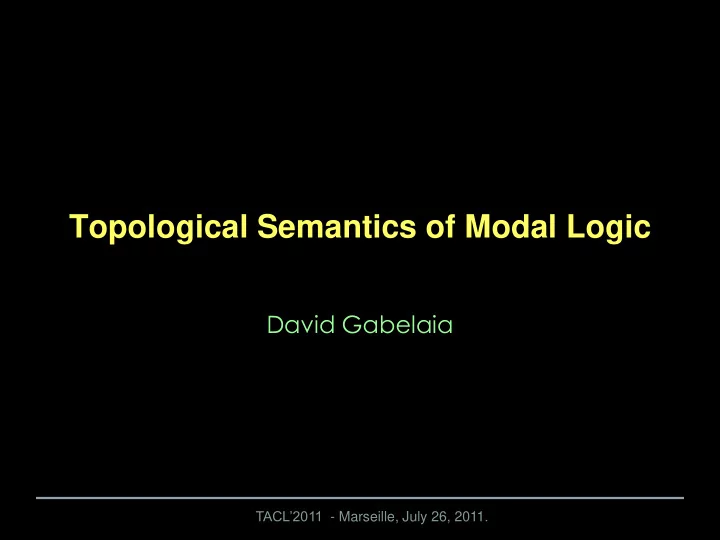

Problems solved • It is straightforward to generalize this procedure to a 3-fork and, indeed, to any n-fork. • Clusters are no problem: – the Cantor set can be decomposed into infinitely many disjoint subsets which are dense in it. – Similarly, an open interval (and thus, any open subset of the reals) can be decomposed into infinitely many disjoint, dense in it subsets. • How about increasing the depth?
Iterating the procedure
Iterating the procedure
Iterating the procedure 1 0 1/3 2/3
Iterating the procedure 1 0 1/3 2/3
Iterating the procedure 1 0 1/3 2/3
Connected logics • What more can a modal logic say about the topology of R in C-semantics? • Consider the closure algebra R + = ( ( R ), C ). Which modal logics can be generated by subalgebras of R + ? Answer: Any connected modal logic above S4 with fmp. [G. Bezhanishvili, Gabelaia 2010] • More questions like this – e.g. what about homomorphic images? What about logics without fmp? • Recently Philip Kremer has shown strong completeness of S4 wrt the real line!
Story of Delia • d-completeness doesn’t straightforwardly follow from Kripke completeness. • Incompleteness theorems. • Extensions allow automatic transfer of d-completeness of GL . • Completeness of GL wrt ordinals. • Completeness of wK4 • Completeness of K4.Grz • Some other recent results.
Story of Delia (d-semantics) Axioms for derivation Axioms of wK4 0 = 0 d = (p q) = p q d (A B) = d A d B p p p dd A A d A wK4 – weak K4 wK4 -frames are weakly transitive. Tbilisi-Munich-Marseille is a transit flight, Tbilisi-Munich-Tbilisi is not really a transit flight.
Story of Delia (d-semantics) Axioms for derivation Axioms of wK4 0 = 0 d = (p q) = p q d (A B) = d A d B p p p dd A A d A wK4 – weak K4 wK4 -frames are weakly transitive.
Story of Delia (d-semantics) Axioms for derivation Axioms of wK4 0 = 0 d = (p q) = p q d (A B) = d A d B p p p dd A A d A wK4 – weak K4 wK4 -frames are weakly transitive. Tbilisi-Munich-Marseille is a transit flight,
Story of Delia (d-semantics) Axioms for derivation Axioms of wK4 0 = 0 d = (p q) = p q d (A B) = d A d B p p p dd A A d A wK4 – weak K4 wK4 -frames are weakly transitive. Tbilisi-Munich-Marseille is a transit flight, Tbilisi-Munich-Tbilisi is not really a transit flight.
wK4-frames xyz(xRy yRz x z xRz) • Weak quasiorders (delete any reflexive arrows in a quasiorder). • Partially ordered sums of weak clusters clusters with irreflexive points:
Delia is capricious (d-incompleteness) • S4 is an extension of wK4 (add reflexivity axiom) • S4 has no d-models whatsoever!! • S4 is incomplete in d-semantics. Reason: The relation induced by d is always irreflexive: x d [x]
Caprice exemplified Topological non-topological
How capricious is Delia? Definition: Weak partial orders are obtained from partial orders by deleting (some) reflexive arrows. • For any class of weak partial orders of depth n, if there is a root-reflexive frame in this class with the depth exactly n, then the logic of this class is d-incomplete.
Gracious Delia • Kripke completeness implies d-completeness for extensions of GL . • GL is the logic of finite irreflexive trees. • In d-semantics, GL defines the class of scattered topologies [Esakia 1981] • GL is d-complete wrt to the class of ordinals. • GL is the d-logic of . [Abashidze 1988, Blass 1990]
Finite irreflexive trees recursively • Irreflexive point is an i-tree. • Irreflexive n-fork is an i-tree. • Tree sum of i-trees is an i-tree.
Finite irreflexive trees recursively • Irreflexive point is an i-tree. • Irreflexive n-fork is an i-tree. • Tree sum of i-trees is an i-tree. What is a tree sum?
Finite irreflexive trees recursively • Irreflexive point is an i-tree. • Irreflexive n-fork is an i-tree. • Tree sum of i-trees is an i-tree. What is a tree sum? Similar to the ordered sum, but only leaves of a tree can be “blown up” (e.g. substituted by other trees).
Tree sum exemplified
Tree sum exemplified
Tree sum exemplified
Tree sum exemplified
Tree sum exemplified
Tree sum exemplified
d-maps • f: X Y is a d-map iff: – f is open – f is continuous – f is pointwise discrete • d-maps preserve d-validity of modal formulas – so they anti-preserve (reflect) satisfiability. • One can show that each finite i-tree is an image of an ordinal via a d-map. • This gives ordinal completeness of GL .
Mapping ordinals to i-trees 0 1 2 3 … [1] [0] [r]
Mapping ordinals to i-trees 0 1 2 3 … [0] [1] [0] [r]
Mapping ordinals to i-trees 0 1 2 3 … [0] [1] [1] [0] [r]
Mapping ordinals to i-trees 0 1 2 3 … [0] [1] [0] [1] [0] [r]
Recommend
More recommend